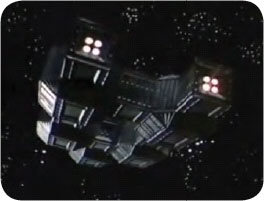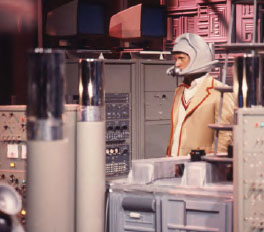THE FACT OF FICTION
Scratching beneath the surface of Doctor Who’s most fascinating tales...
Before Doctor Who began, the original producer, Verity Lambert, asked me to write the very first story, but I was heavily engaged elsewhere and it finished up with Tony Coburn…” so author Terence Dudley claimed in 1988. In fact, 18 years or so passed before Dudley’s first Doctor Who script entered production, in 1981 – but in so many ways, Four to Doomsday comes across as a Doctor Who adventure of 1963-64 vintage.
It’s there in the first TARDIS scene, when the Doctor insists he should exit the ship alone; it’s there when he explores the Control Room, gleefully flicking switches while his companions sigh and argue. Here they are: Adric in the place of his granddaughter Susan, hugely clever but hugely impulsive; dependable, sensible Nyssa in the place of dependable, sensible Barbara; and young lioness Tegan, ever on the verge of exasperation with the fussy Doctor, rather like young lion Ian. It’s there when Nyssa stops for a moment to describe photosynthesis midway through Part Two; it’s there, too, in the jolly performance of guest star Stratford Johns...
But it’s there to its ultimate degree, perhaps, towards the end of Part Three, when Nyssa tells the Doctor how the Chinese Surgeons were going to kill her. “Yes – the devils,” agrees the Doctor, momentarily possessed by the ghost of William Hartnell. Because although there’s much pleasure to be had in watching Doctor Who evoke its own past, in its sometimes naïve attitudes to race, to history and to culture, Four to Doomsday can’t help but look like a relic of a Bigon age.
Part One
FIRST BROADCAST: 18 JANUARY 1982
In flight: a vast spacecraft.
■ Stage directions described the vessel as a disc, whirling through space: ‘Thick at centre and tapering to its edge.’ So a big flying saucer, pretty much!
The TARDIS materialises. The Doctor (Peter Davison) had intended to bring airline stewardess Tegan (Janet Fielding) to Heathrow Airport on 28 February 1981…
■ Tegan’s maiden flight as an air hostess, we’re now told, was scheduled to occur on the same day she made her TV début – on 28 February 1981, when Part One of Logopolis first aired. What’s more, she was scheduled to fly while that episode aired – at 17:30 hours, when the 25-minute Part One began transmission at 17:10!
… but when Adric (Matthew Waterhouse) operates the scanner, it reveals a Space Ship Control Room.
■ “Doesn’t look much like Heathrow to me,” moans Tegan – whereupon a boom mic can be glimpsed hovering over Nyssa’s head!
■ The last time the Doctor was at Heathrow, “they were doing strange things to Terminal 3” – apparently! It’s not clear what these “things” might have been: the addition of the UK’s first moving walkways in 1970, perhaps? Its scheduled demolition in 2019, even? But he’s just as likely to be referring to some unseen adventure…

Monarch’s majestic vessel.
■ Adric claims to have set the coordinates for “the inner spiral arm of Galaxia Kyklos” – earning Tegan’s riposte: “But Heathrow is on the M4, not Corfu!” Why associate the name with the Greek island of Corfu? Because kyklos is Greek for ‘circle’ – or, indeed, any circular body; the reason why, we presume, the Doctor clarifies that Adric means the Milky Way.
Atmospheric readings indicate a low-oxygen environment. While Nyssa (Sarah Sutton) observes advanced technology outside, the Doctor fetches a life support ‘space pack’ – then exits the Ship unaccompanied.
■ Stage directions described the ‘spacepack’ [sic] as ‘a globe of Perspex with respiratory support’ – suggesting that author Terence Dudley envisaged that characters wearing the packs would have their heads fully enclosed, in a sort of ‘fish bowl’.
As he looks around, he’s observed by a floating sphere – which transmits his image to a Throne Room, where three creatures are watching… Meanwhile, Tegan’s patience is wearing thin.
■ Nyssa is reading one of the three volumes of Principia Mathematica (originally 1910-13) by Alfred North Whitehead and Bertrand Russell, a fundamental work concerning symbolic logic – hence the prior reference to one of its two authors in The Tomb of the Cybermen (1967): “a sort of Whitehead logic…”
■ The other two volumes of the Principia can be seen on the console. As originally scripted, Nyssa responded to Adric’s suggestion that Tegan kills time by reading “a fascinating book on maths through there by a chap called Bert [sic] Russell” with the uncharacteristically strident: “Kids’ stuff! Mindless!”
“ Monarch is the greatest being in the known universe. He will destroy Earth if he’s not stopped!”
■ Also amended from the original: when Adric wondered what one of the instruments outside did, Nyssa was directed to indicate the book she was reading before stating, “I thought you’d read this. It increases density.” (Nonsense to suggest that Whitehead and Russell’s Principia would refer directly to unknown instrumentation in a spaceship control room, of course!)
■ Nyssa goes on to state that the instrument in question reduces matter – the Doctor’s, perhaps. Adric thinks this ridiculous, but Nyssa’s reply is left hanging: “Is it?” Terrance Dicks elaborates on Nyssa’s thinking in his Target Books novelisation Doctor Who: Four to Doomsday (1983), explaining how: ‘Matter-compression was a particularly agonising form of death. It was a favourite method of the Master [sic]’ – implying, perhaps, that Nyssa is worried that the Doctor’s arch-enemy has escaped from Castrovalva, and is waiting for him outside!
Returning, the Doctor sends Adric to fetch three more space packs – but warns his companions that outside, they’ll find themselves being watched over by the sphere, a monopticon. He gives Tegan a spare key – then all four exit outside.
■ Nyssa’s claim that the interferometer identified by the Doctor measures gravitation waves isn’t entirely unscientific – interferometry indeed concerns the measurement of waveforms.
■ No-one appears to activate the TARDIS doors – seemingly, they open of their own accord.
■ As the TARDIS travellers head out, the voice of Control (Philip Locke, uncredited) reports back to the lead watcher: “Molecular structure of intruding artefact consistent with destination Earth…” According to Dicks: ‘Control was the giant computer responsible for the routine operation of the ship. Its sensors were everywhere, it observed and regulated every function, so much so that the ship itself was almost a living creature.’
The Doctor asks the monopticon to take him to its leader… and a door slides open at the top of some stairs.
■ “Look!” cries Tegan, pointing up to the door – but it’s only then that the door slides open!
Leaving Adric and Nyssa behind, the Doctor and Tegan enter a Linkway – where another monopticon guides them on. The watching female wonders how Earthlings can have penetrated their ship; their leader wonders if their technology is now as advanced as his own. Eventually, the Doctor and Tegan arrive in the Throne Room, where the senior of the three green-skinned aliens (Stratford Johns) introduces himself as Monarch, “supreme leader of the people of Urbanka, in the solar system of Inokshi in the galaxy RA 1489”; his underlings are Enlightenment (Annie Lambert) and Persuasion (Paul Shelley).
■ In a series of interviews conducted throughout 1988 and eventually compiled in Talkback: The Unofficial and Unauthorised Doctor Who Interview Book: Volume Three: The Eighties (Telos Publishing, 2007), Terence Dudley would describe Four to Doomsday as ‘a travesty’, since ‘Monarch, Persuasion and Enlightenment were written as three large South American tree frogs, two of which later take human form. What I got were three made-up actors, allowing Stratford Johns to be recognisable in a leading role.’ Specifically, Dudley didn’t want something recognisably humanoid, but ‘a frog: a highly intelligent frog. It seemed to me quite a frightening concept.’ In fact, Dudley’s stage directions required Monarch to resemble ‘an amalgam of South American frog and sea anemone’ – so not quite as straightforward a description as he later implied. Make-up artist Dorka Nieradzik’s final design eschewed the ‘sea anemone’ part, since the Urbankans are entirely devoid of the most immediately obvious feature of the sea anemone – its wavy fronds. (Part Two, nonetheless, contains a hangover from Dudley’s original ‘anemone’ idea – as we’ll see…)

The Doctor explores the alien laboratory.
■ Nonetheless, it’d be true to say that Nieradzik’s design is more warty and toad-like than the typical South American tree frog – one particular example of which had become, surprisingly, something of an icon of the era! A striking photograph of a smooth-skinned, red-eyed Panamanian tree frog featured on the cover of David Attenborough’s Life on Earth (1979) – the bestselling book of the groundbreaking BBC natural history series, displayed on every middle-class coffee table in the early 1980s. Surely that famous image, taken by Attenborough himself, was more what Dudley had in mind…?
■ [Alan] Stratford Johns was best known for playing investigating officer Barlow in BBC police procedural Z Cars (and its many iterations; see Where Else Have I Seen…?); he later claimed that onetime BBC Drama head Shaun Sutton had proposed he might replace Second Doctor Patrick Troughton. Like so many other 1980s Doctor Who guest stars, Johns was roped in to appear in producer John Nathan-Turner’s onenightonly Drury Lane Cinderella in December 1973 (playing one of several Village Policemen); then, in 1975, Nathan-Turner had worked as a production assistant on Johns’ star vehicle Barlow. On being cast in Four to Doomsday, Johns later told the magazine In Vision how “the BBC sent some people round from their make-up department to take a mask” – a “‘huge frog head with eyes out here that light up and stuff,’” apparently! He claimed to have phoned the director to tell him: “‘If you’ve got ideas like that, why don’t you get another fat actor?! If nobody can recognise me, there’s no point paying my money!’” Hence the decision to use an elaborate make-up, not a mask…
■ Dudley intended Monarch’s underlings to wear designs coloured according to gender stereotypes: ‘Enlightenment is marked pink – Persuasion blue.’
With “full life support atmosphere” now in place, the Doctor and Tegan can remove their space packs. Tegan’s Earth clothing interests Enlightenment, who claims they last visited her planet 2,500 years ago.